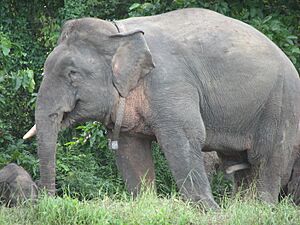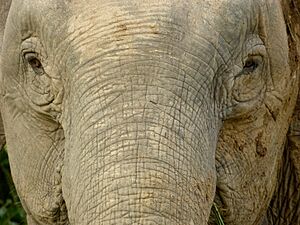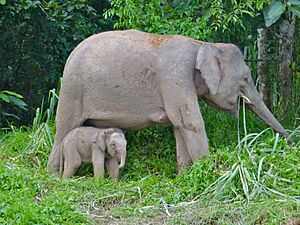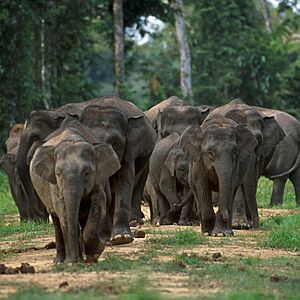Borneo elephant facts for kids
Quick facts for kids Borneo elephant |
|
|---|---|
 |
|
| Scientific classification |
|
| Kingdom: | Animalia |
| Phylum: | Chordata |
| Class: | Mammalia |
| Order: | Proboscidea |
| Family: | Elephantidae |
| Genus: | Elephas |
| Species: | |
| Subspecies: |
E. m. borneensis
|
| Trinomial name | |
| Elephas maximus borneensis Deraniyagala, 1950
|
|
The Borneo elephant, also known as the Borneo pygmy elephant, is a special type of Asian elephant. It lives in the wild forests of northeastern Borneo, which is part of Indonesia and Malaysia. Scientists are still debating where these elephants originally came from.
Since 1986, the Asian elephant has been listed as Endangered on the IUCN Red List. This means their numbers have dropped by at least half over the last 60 to 75 years. The biggest dangers to these elephants are losing their homes, their habitats becoming damaged, and their living areas getting broken up into smaller pieces.
For a long time, people thought the Sultan of Sulu brought these elephants to Borneo in the 1700s. They were then released into the jungle. However, recent DNA studies show that Borneo elephants probably came from the Sundaland area. This means they are native to Borneo, not brought there by humans. Their unique genes show they are a very important group for elephant conservation.
Contents
What Makes Them Special?

Asian elephants are generally smaller than African elephants. The highest part of their body is on their head. The tip of their trunk has one finger-like part. Their back is usually curved or flat.
People often call the Borneo elephant a 'pygmy' (meaning very small) elephant. But adult Borneo elephants in Sabah are actually similar in height to other Asian elephants in Peninsular Malaysia. Some measurements of their skulls are a bit smaller than those of Sumatran elephants. Overall, they are about the same size as other elephants in the Sunda region.
Scientists have also noticed that Borneo elephants are very calm and gentle. This is another reason why some people once thought they might have come from a group of domesticated elephants.
Where Do They Live?
Borneo elephants only live in the northern and northeastern parts of Borneo. In the 1980s, there were two main groups. One group lived in Sabah, in places like the Tabin Wildlife Reserve. The other group lived in the hilly forests of the island's interior. In Kalimantan, their home is a small area near the upper Sembakung River.
It seems their living area has not grown much in the last 100 years. This is even though there are other suitable places on Borneo. Scientists think the elephants' spread might be limited by the type of soil. Borneo's soil is often not very fertile, and elephants need certain natural minerals.
Surveys in Sabah have estimated the elephant population. In 1992, there were thought to be between 500 and 2,000 elephants. A more recent survey from 2007 to 2008 suggested there were between 1,184 and 3,652 elephants. Their numbers change depending on how much forest is lost or broken up by human activities like logging.
Studies show that elephant families need a large area to live in. In forests that are not broken up, they might use an area of about 250 to 400 square kilometers. But in forests that are broken up, they might need an even larger area, around 600 square kilometers.
Dangers They Face
The biggest dangers to Asian elephants today are losing their homes, their habitats getting damaged, and their living areas being split up. This happens because the human population is growing. When elephants lose their homes, they often come into contact with people. This can lead to conflicts, especially when elephants eat or step on crops. Sadly, hundreds of people and elephants are killed each year because of these conflicts.
As human towns and farms expand, they block the elephants' travel routes. This also reduces the elephants' food sources and destroys their natural homes.
Another problem is not enough trees, often due to logging. Borneo elephants need a lot of water every day, about 100 to 225 liters. If it's hard for them to find water because of climate changes or logging, they have to move to new places to survive.
Protecting Them
The Asian elephant (Elephas maximus) is listed under CITES Appendix I. This means it is highly protected from international trade. Because Borneo elephants are so unique genetically, they are a top priority for conservation efforts.
In Malaysia, Borneo elephants are protected by law. Anyone caught hunting elephants can face a large fine or a long time in prison.
The Oregon Zoo in Portland, USA, has the only Borneo elephant in the United States. Her name is Chendra. She was found alone near a palm oil plantation with gunshot wounds. She lost sight in one eye. Malaysian wildlife officials helped her find a new home, and she arrived at the Oregon Zoo in 1999.
In 2016, a rescued Borneo elephant in a Japanese zoo got tuberculosis. The elephant got better, but scientists are still trying to figure out how it got sick.
Their History
Scientists have long wondered if Borneo elephants are native to the island or if they came from elephants given to the Sultan of Sulu in 1750. These elephants were then set free in northern Borneo.
However, in 2003, studies of their mitochondrial DNA showed something amazing. They found that Borneo elephants came from the Sundaic region. But they have been evolving separately on Borneo for about 300,000 years! They likely became separated from other Asian elephants when the land bridges connecting Borneo to other islands and the Asian mainland disappeared after the last Ice Age, about 18,000 years ago.
Long ago, elephants were often given as gifts between rulers. In the 1300s, the ruler of Java gave two elephants to the ruler of Sulu. These animals might have been the ancestors of some wild elephants in Borneo. When explorers like Ferdinand Magellan's crew visited Brunei in 1521, they saw people riding elephants to the palace. But by the 1770s, this custom had stopped. People then reported seeing wild elephant herds that were hunted.
Some stories say that the Sultan of Sulu shipped his valuable Javan elephants to Borneo. This was because he needed more land for them and wanted them to help move logs for building ships. When a certain agreement was signed, many of these gentle, partly domesticated elephants were released into the forests. This allowed them to live deep in the jungle, away from any conflicts. This act of releasing them helped save the elephants that are still there today.
Recent DNA studies confirm that Borneo elephants are unique. They split from other Asian elephant groups about 300,000 years ago.
See also
- Dwarf elephant
- Insular dwarfism
- Kallana



